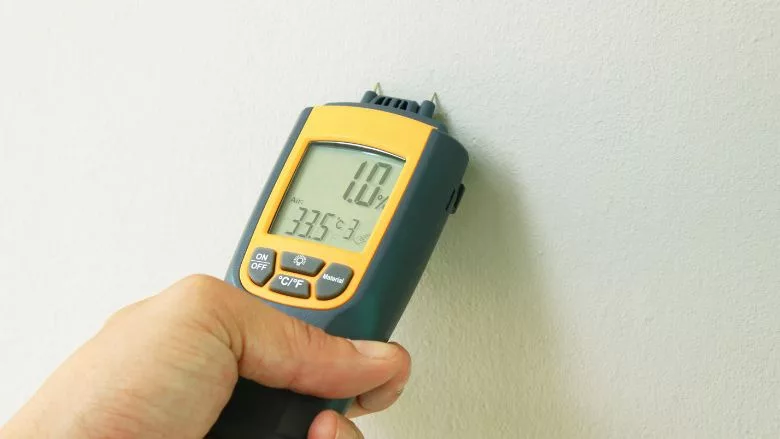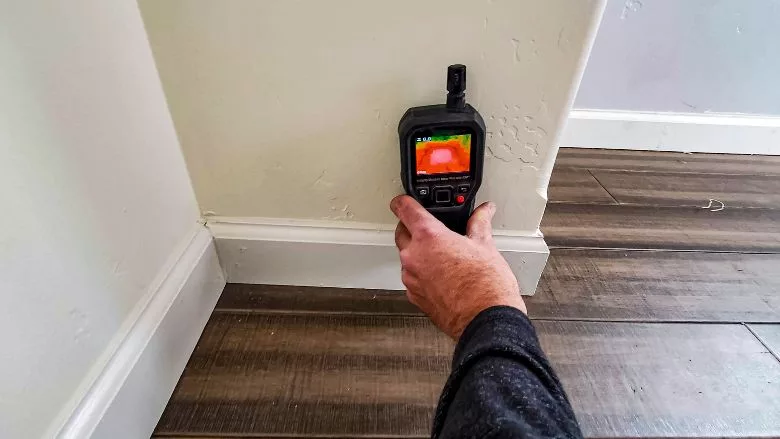It’s Not Drying... WHY?
Just because your moisture meter isn't reading "dry" doesn't mean that progress isn't being made.


You’ve been there. It is day two of a drying project and the numbers on your moisture meter are the same on as they were on day one. Your wet materials don’t seem to be making drying progress. At this point, the most common response is to grab the demolition tools and start removing the wet materials… which may be the completely wrong course of action.
These wet materials might be making perfectly acceptable drying progress, but your meter is not able to show it. This can happen for a number of reasons, including false positives, surface moisture and meter scale limitations.
FALSE POSITIVES
False positives are readings on a moisture meter that indicate “wet,” even though the material is actually dry. If your meter is returning a false positive, the material would appear to be wet when it is actually making progress – or even dry. Moisture meters are subject to false positive readings for a number of reasons that are well documented in the industry.
Non-invasive meters have more false positives than penetrating meters. The most common cause is metal hidden in or behind the material being checked. Corner beads, metal studs, foil-backed insulation and metal lath in plaster walls are all common examples. Dense materials such as concrete and plaster also read “wetter” on a non-invasive meter. These phenomena occur because a non-invasive meter is sending a signal into the material and looking for what energy is reflected back. The more energy reflected back, the higher the reading. Denser materials tend to reflect more of this energy back. The meter reads “wet” even though the material may not be wet.
Solutions to false positives on a non-invasive meter: Double-check the reading with a penetrating meter or a thermal imaging camera.
Penetrating meters are not immune to false positives. A penetrating meter’s most common false positive is produced by the presence of certain chemicals in the material. These chemicals could be salts from urine or wood treatment chemicals. Adhesives in engineered wood materials can occasionally read “wet,” but this is rare. Another possible false reading results from a meter malfunction – especially from a loose or broken wire in a hammer probe. Since penetrating meters are just measuring the resistance between the two pins, anything that reduces the resistance will read “wet.” Salts, chemicals and a crossed wire in the hammer probe head can all reduce this resistance and cause a material to appear wet when it’s actually perfectly dry.
Solutions to false positives on a penetrating meter: Double-check the reading with non-penetrating meter. Compare the penetrating reading to the same unaffected material in the structure to see what a reasonable drying goal is. Use an ultraviolet light to inspect for urine salts.
SURFACE MOISTURE
Surface moisture has a dramatic effect on non-invasive meters. All non-invasive meters will read higher when the moisture in the top 1/8 in. of a material is high – even if the rest of the material is fairly dry. Some non-invasive meters only read the wettest layer of the material – and will completely ignore the dry areas.
Penetrating meters, if used improperly, have the same weakness. Many penetrating meters use non-insulated pins. Non-insulated pins simply report to the user about the wettest layer they are touching – which is most often the surface. Since electrical current follows the path of least resistance, the wet surface will be the only part of the material the meter is reading.
Solutions to surface moisture: Look at the surface – is it visibly wet? When using non-invasive meters, take multiple locations to view progress more clearly – especially wicking height in the walls. When using penetrating meters, use insulated probes whenever possible to determine the moisture at different depths of the material.
METER SCALE LIMITATIONS
All moisture meters have limits. Just as your 25-foot measuring tape couldn’t tell you the height of the Golden Gate Bridge, sometimes the scale on a moisture meter is not large enough to show how wet a material is. Moisture meters (both penetrating and non-invasive) are most accurate between 7% and 30% moisture content in wood. Since wood and several other materials are able to hold more than 30% moisture content, meter manufacturers have a decision to make: How high should the scale go?
Some manufacturers stop the scale at 30% with the idea that since readings above 30% are not that accurate, why display them? Some meter manufacturers stop the scale somewhere between 40% and 100% with the statement in the manual explaining about how readings aren’t as accurate above 30%.
Whichever stopping point a manufacturer chooses for their meter – there will still be times when a material’s actual moisture content is above the limit. Some wood species, for example, can hold almost 250% moisture content! So even the 100% meter wouldn’t know when the material is higher than the scale maximum.
Here’s the lesson: You will have situations where your moisture meter reads the maximum value on day one. Then, on day two, the meter still reads the maximum value. Many restoration companies would give up at this point and perform demolition on the material. This decision might be a common response in the industry but it might not be the best decision for your company or your customers.
Solution to meter scale limitations: Train technicians that when meters are reading the maximum value in one location on day one to also document an area which is not at maximum. This second area may show more clearly whether progress is being made.
PULL THE PLUG
I am not suggesting that removing a wet material is always wrong. If materials are contaminated or damaged, or if the structure has multi-layer wall or floor assemblies, demolition may be the best choice. If at any time during a drying project you detect strong or unusual microbial odors, the best course of action is to investigate further and find the source of the odors.
Ultimately, a skilled restorer with a good moisture meter will be able to dry more wet materials efficiently, leading to happy customers and fatter wallets.
Looking for a reprint of this article?
From high-res PDFs to custom plaques, order your copy today!



